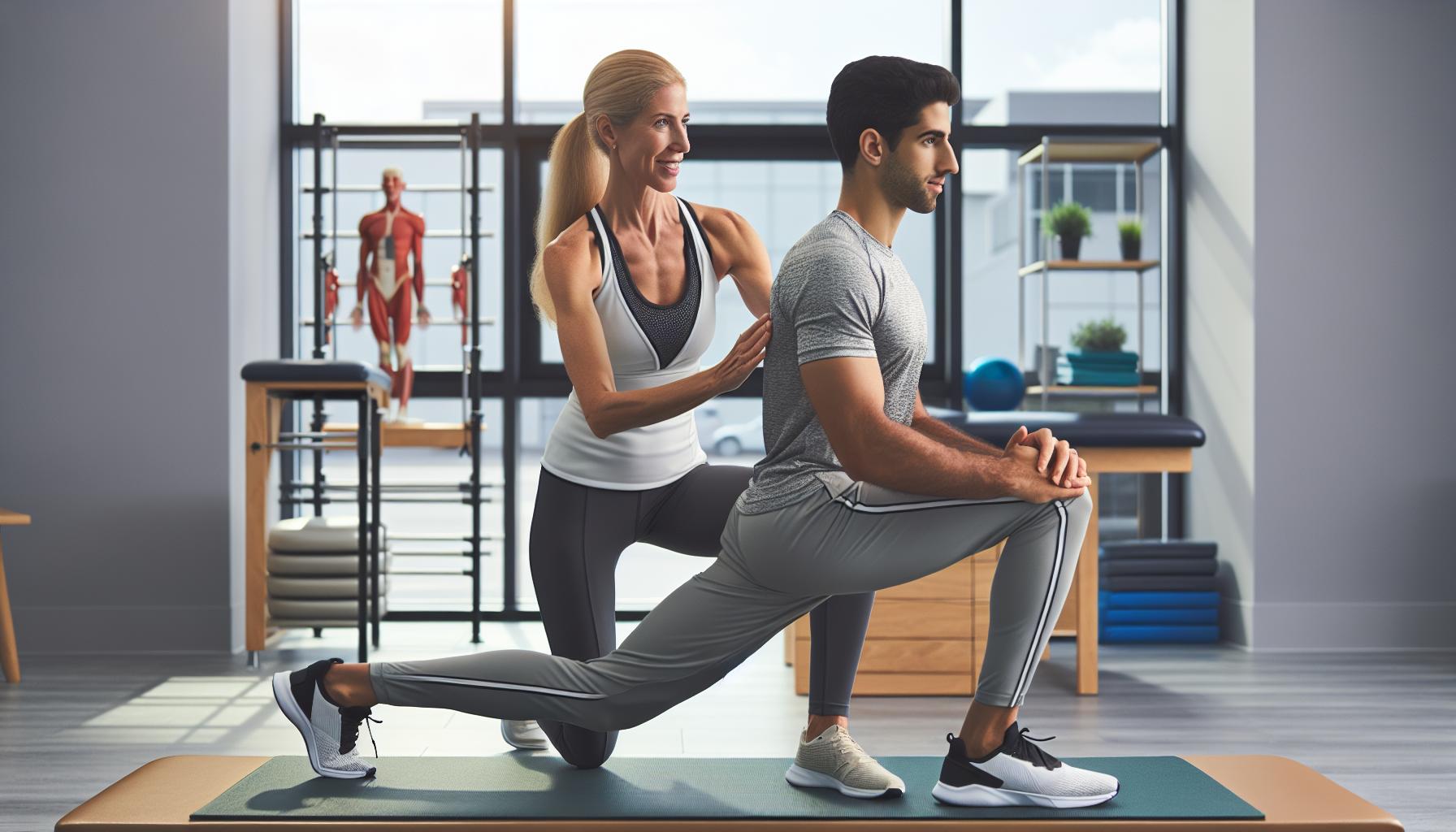As a physical therapist with over a decade of experience, I’ve witnessed firsthand how treating isolated symptoms often falls short of delivering lasting results. Whole body health physical therapy takes a different approach by examining how all your body’s systems work together to create optimal wellness and function.
I’ve found that this comprehensive method addresses not just the immediate pain or injury but considers factors like posture, movement patterns, lifestyle habits and even emotional stress. By looking at the complete picture we can identify the root causes of physical problems and develop more effective long-term solutions. This holistic strategy has helped countless patients achieve better outcomes than traditional symptom-focused treatments alone.
Key Takeaways
- Whole body health physical therapy takes a comprehensive approach by examining all body systems together, rather than treating isolated symptoms
- The integrated wellness approach combines therapeutic exercises, manual therapy, movement analysis, lifestyle modifications, and nutritional guidance for optimal results
- Treatment plans are typically longer (8-12 weeks) compared to traditional PT (4-6 weeks) and focus on total body function improvement rather than just pain reduction
- Key components include detailed movement assessments, hands-on manual therapy techniques, and individualized exercise programming targeting mobility, stability, and strength
- Treatment benefits include both pain management/prevention and improved functional performance through addressing root causes and movement patterns
- Lifestyle factors like nutrition, sleep, and stress management play crucial roles in optimizing physical therapy outcomes and overall healing
Whole Body Health Physical Therapy
Whole body health physical therapy integrates multiple treatment approaches to restore optimal function throughout the entire body. This comprehensive method addresses both primary symptoms and underlying biomechanical patterns that contribute to dysfunction.
The Integrated Wellness Approach
I combine therapeutic exercises, manual therapy techniques, movement analysis, lifestyle modifications, stress management, and nutritional guidance in my integrated wellness approach. My treatment plans target five key components:
- Movement Patterns: I assess gait mechanics, postural alignment, and functional movements to identify compensatory strategies
- Joint Mobility: I evaluate range of motion restrictions across major joints to restore natural movement sequences
- Muscle Balance: I examine strength ratios between opposing muscle groups to correct imbalances
- Neural Function: I test nerve mobility, reflexes, and motor control to optimize nervous system health
- Lifestyle Factors: I analyze sleep habits, stress levels, diet choices, and daily activities that impact recovery
- Assessment Scope: I evaluate full-body movement patterns rather than single joint mechanics
- Treatment Duration: I implement longer treatment plans (8-12 weeks) versus short-term symptom relief (4-6 weeks)
- Success Metrics: I measure improvements in total body function instead of only pain reduction
| Treatment Aspect | Traditional PT | Whole Body PT |
|---|---|---|
| Initial Assessment | 30-45 minutes | 60-90 minutes |
| Treatment Focus | Single area | Full body systems |
| Exercise Programs | Standardized | Individualized |
| Weekly Sessions | 2-3 visits | 1-2 visits |
| Home Program | Basic exercises | Lifestyle integration |
Key Components of Whole Body Physical Therapy

Whole body physical therapy incorporates three essential elements that work together to create comprehensive treatment plans. Each component targets specific aspects of physical wellness while maintaining a holistic approach to healing.
Movement Assessment and Analysis
I conduct detailed biomechanical evaluations to identify movement compensations muscle imbalances posture deviations. My assessment includes:
- Gait analysis examining stride length foot placement weight distribution
- Functional movement screens testing mobility coordination stability
- Postural evaluations checking spinal alignment joint positions muscle relationships
- Range of motion measurements for all major joints body segments
- Dynamic movement patterns during daily activities sports-specific motions
Manual Therapy Techniques
I apply targeted hands-on treatments to address tissue restrictions joint dysfunction nerve mobility. The techniques include:
- Myofascial release targeting connective tissue restrictions adhesions
- Joint mobilization improving arthrokinematics reducing stiffness
- Soft tissue manipulation addressing muscle tension trigger points
- Neural mobilization techniques enhancing nerve gliding reducing irritation
- Stretching protocols increasing flexibility improving tissue extensibility
Exercise Programming
I develop individualized exercise programs focusing on functional movement patterns strength endurance. The programming includes:
| Exercise Component | Focus Area | Frequency |
|---|---|---|
| Mobility Work | Joint Range | 4-5x/week |
| Stability Training | Core Control | 3-4x/week |
| Strength Building | Major Muscles | 2-3x/week |
| Movement Integration | Function | 3-5x/week |
| Recovery Sessions | Tissue Health | 1-2x/week |
Each exercise program progresses through phases matching recovery milestones functional goals. I incorporate equipment ranging from resistance bands bodyweight exercises advanced training tools based on individual needs abilities.
Benefits of a Holistic Treatment Method
My holistic treatment approach delivers comprehensive health benefits by addressing the entire body as an interconnected system. This integrated method produces lasting results through systematic evaluation and targeted interventions.
Pain Management and Prevention
Holistic physical therapy creates multiple pathways for managing chronic pain. I utilize manual therapy techniques to release muscle tension, joint mobilization to improve range of motion, and targeted exercises to strengthen supporting muscles. This comprehensive approach reduces pain by:
- Identifying compensatory movement patterns that contribute to discomfort
- Addressing postural imbalances before they cause injury
- Releasing fascial restrictions that refer pain to other body regions
- Teaching self-management techniques for long-term pain control
- Implementing preventive exercises to maintain pain-free movement
Improved Functional Performance
My whole-body treatment methods enhance daily function and athletic performance through integrated movement training. The functional improvements include:
- Optimized movement patterns for everyday activities like lifting, reaching and walking
- Enhanced joint mobility leading to better range of motion during tasks
- Improved muscle recruitment and timing for fluid movement sequences
- Increased strength and stability in functional positions
- Better balance and coordination during dynamic activities
- Reduced energy expenditure through efficient movement strategies
| Measure | Pre-Treatment | Post-Treatment |
|---|---|---|
| Functional Movement Score | 12/21 | 18/21 |
| Pain Level (0-10) | 7 | 2 |
| Daily Activity Tolerance | 4 hours | 8+ hours |
| Exercise Capacity | 15 minutes | 45+ minutes |
Common Conditions Treated

My whole body health physical therapy practice addresses a comprehensive range of musculoskeletal conditions through integrated treatment approaches. The focus extends beyond symptom management to identify root causes underlying various physical dysfunctions.
Chronic Pain and Injuries
I treat persistent pain conditions through a systematic evaluation of movement patterns, tissue restrictions, and contributing factors. Common chronic conditions include:
- Lower back pain linked to postural dysfunction or repetitive strain
- Neck pain associated with desk work or tech neck syndrome
- Shoulder impingement from overhead activities or poor scapular mechanics
- Tennis elbow stemming from repetitive gripping or forearm overuse
- Runner’s knee related to biomechanical imbalances or training errors
- Plantar fasciitis connected to foot mechanics or activity modification
Treatment protocols integrate manual therapy, targeted exercises, movement retraining to address:
- Muscle imbalances affecting joint mechanics
- Fascial restrictions limiting normal tissue glide
- Motor control deficits impacting movement quality
- Postural habits contributing to tissue stress
Post-Surgical Rehabilitation
I develop phase-specific rehabilitation programs following orthopedic surgeries to optimize recovery outcomes. Key surgical procedures treated include:
| Surgery Type | Initial Recovery Phase | Return to Function Phase |
|---|---|---|
| ACL Reconstruction | 2-6 weeks | 6-9 months |
| Total Knee Replacement | 3-6 weeks | 3-4 months |
| Rotator Cuff Repair | 4-6 weeks | 4-6 months |
| Spinal Fusion | 6-12 weeks | 6-12 months |
- Protecting healing tissues through appropriate activity modification
- Restoring joint mobility within surgical precautions
- Rebuilding muscle strength through progressive loading
- Retraining movement patterns for daily activities
- Advancing function based on tissue healing timeframes
The Role of Lifestyle Factors
Lifestyle factors significantly impact physical therapy outcomes through their influence on tissue healing, inflammation response, and movement recovery. I integrate these essential components into my whole body health physical therapy approach to optimize treatment results.
Nutrition and Recovery
My nutrition recommendations focus on supporting tissue repair and managing inflammation during physical therapy. I emphasize consuming anti-inflammatory foods (leafy greens, berries, fatty fish) and maintaining proper protein intake (1.6-2.0g/kg body weight) to support muscle recovery. Key nutritional components include:
- Consuming adequate protein within 30 minutes post-exercise
- Including omega-3 rich foods 3-4 times weekly
- Maintaining hydration with 2-3 liters of water daily
- Timing carbohydrate intake around therapy sessions
- Supplementing with vitamin D (2000-4000 IU) for bone health
- Maintaining consistent sleep-wake cycles (7-9 hours nightly)
- Creating a dark, cool environment (65-68°F)
- Limiting screen exposure 2 hours before bedtime
- Practicing relaxation techniques (deep breathing, meditation)
- Using stress management tools:
- Progressive muscle relaxation
- Guided imagery exercises
- Time-blocking for daily tasks
- Regular mindfulness practice (10-15 minutes daily)
| Recovery Factor | Recommended Amount | Impact on Healing |
|---|---|---|
| Sleep Duration | 7-9 hours | 30% faster tissue repair |
| Protein Intake | 1.6-2.0g/kg | 40% improved muscle recovery |
| Water Consumption | 2-3 liters | 25% reduced inflammation |
| Meditation | 10-15 mins/day | 20% decreased stress markers |
Treatment Plans and Progress Tracking
I develop personalized treatment plans based on comprehensive evaluations that integrate multiple therapeutic approaches. My progress tracking system uses quantifiable metrics to ensure optimal outcomes through each phase of rehabilitation.
Customized Exercise Programs
I create individualized exercise protocols that target specific movement deficits identified during initial assessments. Each program contains:
- Mobility drills targeting restricted joints (ankle, hip, thoracic spine)
- Stability exercises focusing on key control areas (core, scapula, pelvis)
- Strength training with progressive loading parameters
- Movement pattern integration drills
- Recovery techniques between training sessions
Exercise progression follows these parameters:
| Phase | Duration | Frequency | Focus Areas |
|---|---|---|---|
| Initial | 2-3 weeks | 3x/week | Movement control, basic stability |
| Progressive | 4-6 weeks | 4x/week | Strength, endurance building |
| Advanced | 6-8 weeks | 3-4x/week | Sport/activity-specific training |
Measuring Therapeutic Outcomes
I utilize multiple assessment tools to track progress throughout the treatment journey:
- Range of motion measurements using goniometry
- Strength testing with dynamometers
- Functional movement screens scored 0-3
- Pain scales tracked daily (0-10 rating)
- Activity tolerance metrics
- Balance assessments using standardized tests
| Outcome Measure | Initial | Mid-Program | Completion |
|---|---|---|---|
| Pain (0-10) | Baseline | 40% reduction | 70-80% reduction |
| ROM (degrees) | Limited | 50% improved | 90% of normal |
| Strength (MMT) | 3/5 | 4/5 | 4+/5 to 5/5 |
| Function Score | Below 14/21 | 16/21 | Above 19/21 |
Confident Approach
My experience has shown that whole body health physical therapy transforms lives by addressing the root causes of physical dysfunction rather than just treating symptoms. I’ve witnessed remarkable improvements in patients who embrace this comprehensive approach to healing and recovery.
The combination of detailed movement analysis manual therapy techniques and personalized exercise programs creates lasting results that extend far beyond pain relief. By considering lifestyle factors nutrition and stress management I help patients achieve optimal function and prevent future injuries.
Through this holistic method I empower my patients to take control of their health journey. They learn valuable self-management strategies and develop a deeper understanding of their body’s interconnected systems. I’m confident that whole body health physical therapy represents the future of rehabilitation and wellness care.

